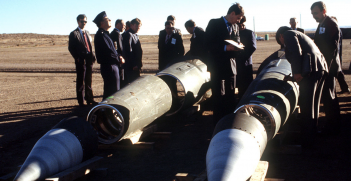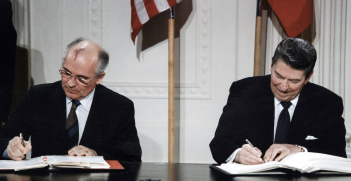North Korea's Nuclear Weapons and Australia's National Security

The dismantling of North Korea’s Punggye-ri nuclear testing site started this week. What are the implications of the North Korean nuclear issue for Australian national security?
The last six months have seen a number of major developments in North Korea’s nuclear weapons program including North Korea’s sixth nuclear test; the validation by the international press of North Korea’s ability to develop miniaturised nuclear warheads; and the successful testing of the Hwasong-15 ICBM capable of striking as far as the continental US. These developments represent a significant improvement in North Korea’s nuclear weapons capabilities, including its much sought-after ability to strike the US mainland.
Much effort has gone into examining the implications of these nuclear developments for the US-Japan-South Korea bloc. Much less attention has been afforded to how such developments stand to affect the national security of other regional powers, such as Australia, given its hostile relationship with Pyongyang and its longstanding security partnership with the US.
Is Australia in the hermit kingdom’s firing line?
Recent analysis on North Korea’s nuclear doctrine by the European Council on Foreign Relations has shown no explicit statement of intent to strike Australian targets, though “US military bases in the operational theatres in the Pacific” have been identified by Pyongyang as potential counterforce targets. This broad construct notionally includes the joint US-Australian military base in Darwin (Robertson Barracks), which Pyongyang has decried as a “front-line base for the US invasion of the DPRK”, subsequently threatening Australia with ‘disaster’ should cooperation with the US continue.
Despite such indictments, there is little reason to believe that Robertson Barracks, or indeed any Australian target, would figure in a North Korean nuclear strike plan. Geo-strategically, North Korea is principally concerned with preventing a US-led military attack that could threaten the survival of the Kim regime. In the event that North Korea finds itself fighting for its survival against a US-led invasion, it’s unlikely that it would expend its limited supply of nuclear-armed intercontinental ballistic missiles (ICBMs) on marginal military targets in Australia when more meaningful counterforce targets exist in South Korea, Japan, and elsewhere in Hawaii, Guam and the mainland US.
Whilst a direct nuclear strike on Australia in the context of a war on the Korean peninsula seems unlikely, Australia might still find itself subject to North Korean threats of nuclear harm. Specifically, Australia could come into a ‘triangular deterrence’ arrangement with the US in which North Korea uses the threat of nuclear strikes against Australian targets to deter US military adventurism in North Korea. It’s assumed that the US would not be willing to pursue military intervention in North Korea if doing so risked the wellbeing of one of its most stalwart allies.
Such North Korean threats would be more credible than threats of direct nuclear strikes against the US for a number of reasons. Firstly, unlike the US and its Northeast Asian allies, anti-ballistic missile shields do not protect Australia. This means that a nuclear strike against Australia would have a higher probability of success. Secondly, a nuclear strike against the US would almost certainly incite retaliation, leading to the destruction of the North Korean polity, whereas the US might demure from retaliating in kind to a nuclear strike on Australia in order to protect its own cities from North Korean strikes.
China’s place in the nuclear equation
There are numerous reasons to doubt that North Korea would ever bring Australia in as a proxy in its nuclear deterrence strategy against the US. First, explicit nuclear threats against Australia would more than likely attract recriminations from one of North Korea’s last political and economic lifelines, China, who has a vested interest in political and military stability in Australia. A nuclear strike against Australia would risk China’s extensive economic interests in Australia and the large Chinese diaspora that resides in Australian cities. Credible threats of a strike could increase the potential for closer security cooperation between the US and Australia, which could ultimately also be directed toward containing China’s rise in the Asia Pacific.
Second, apart from the Australian alliance with the US and activism on expanding sanctions against Pyongyang, Australia doesn’t figure prominently in North Korean strategic calculations. For North Korea to open another front on its multi-front war for survival by threatening Australia would be a backward step in its attempt to normalise its regional security environment. And last, (rather ironically), threatening Australia with nuclear strikes would be against North Korean law. In 2013 the North Korean Supreme People’s Assembly introduced a law stating: “the DPRK shall neither use nukes against the non-nuclear states nor threaten them with those weapons unless they join a hostile nuclear weapons state in its invasion and attack on the DPRK.”
The real threat posed to Australia by the North Korean nuclear weapons program is more indirect and long-term, yet it could ultimately prove just as disastrous.
Assessing the climate of indirect threats by North Korea
Increasing nuclear tensions in Northeast Asia stand to harm Australia’s regional economic interests. A deteriorating regional security environment brought about by nuclear tensions on the peninsula could lead to real economic harm and place tens of thousands of Australians at risk, with the outbreak of an actual nuclear war spelling disaster on these fronts.
North Korea’s nuclear weapons development stands to undermine the value that Australia derives from its security alliance with the US. The US’ inability to reign in a despotic upstart that has, since the early 2000s, been both openly touting its nuclear weapons development and threatening the US and its allies with nuclear harm, lays bare the limits of US power in the Asia Pacific — the assumption of which has been the foundation of Australian defence policy for the last 70 years. US allies that face immediate North Korean threats, namely South Korea and Japan, will have to take greater measures to independently secure themselves against North Korean nuclear aggression. As South Korea and Japan begin fending for themselves, the US’ hub-and-spokes framework of regional alliances will weaken, as will the US’ overall influence in the region. As Australia balances its security and economic interests between the US and China, it will have to think critically about the ongoing benefits of security cooperation with the US and consider how it might fill this strategic vacuum with a rising and revisionist China.
The North Korean nuclear breakout threatens the sanctity of the international community’s non-proliferation ideal. With each new case of nuclear proliferation, the normative power of the Treaty on the Non-Proliferation of Nuclear Weapons recedes a little more, and Australia must take more seriously the prospect of having to defend itself in a world of nuclear multi-polarity. As more nuclear poles emerge, Australia could find itself facing a more direct nuclear threat than that posed by North Korea and doing so without the once unassailable power of its superpower patron.
Christopher J. Watterson is a PhD candidate at the University of Sydney’s Department of Government and International Relations. He lectures in East Asian politics at Australian Catholic University.
This article is an extract from an article titled “What North Korea’s Nuclear Weapons Mean for Australian National Security” published by Quarterly Access in April 2018 and is republished with permission.





